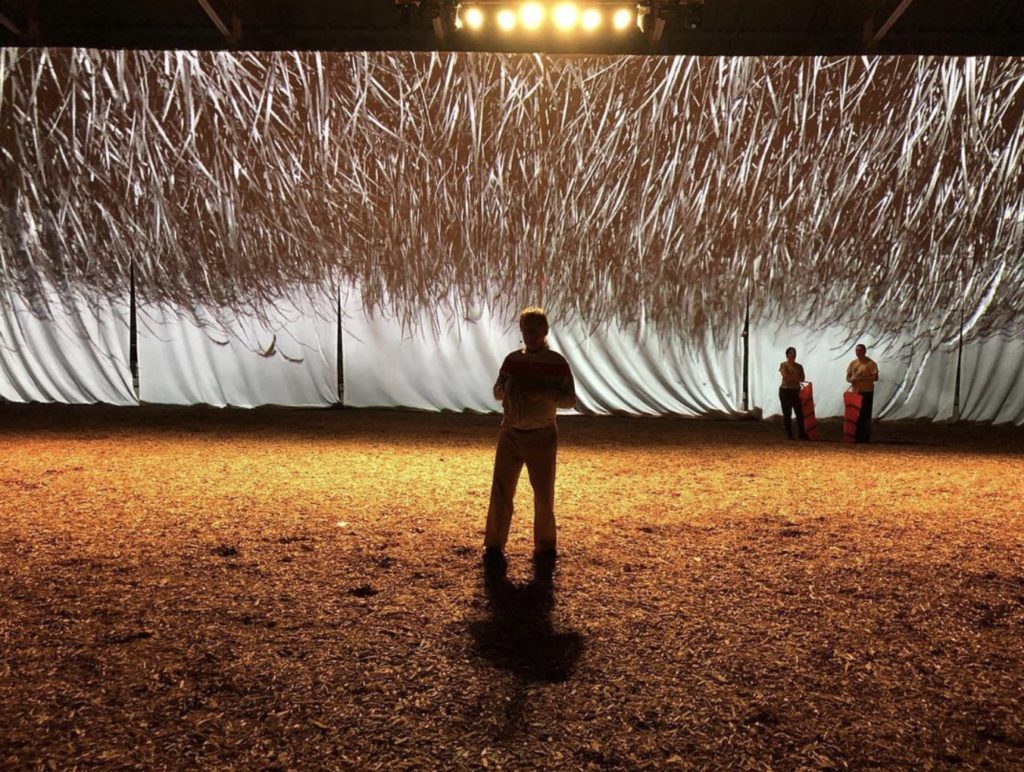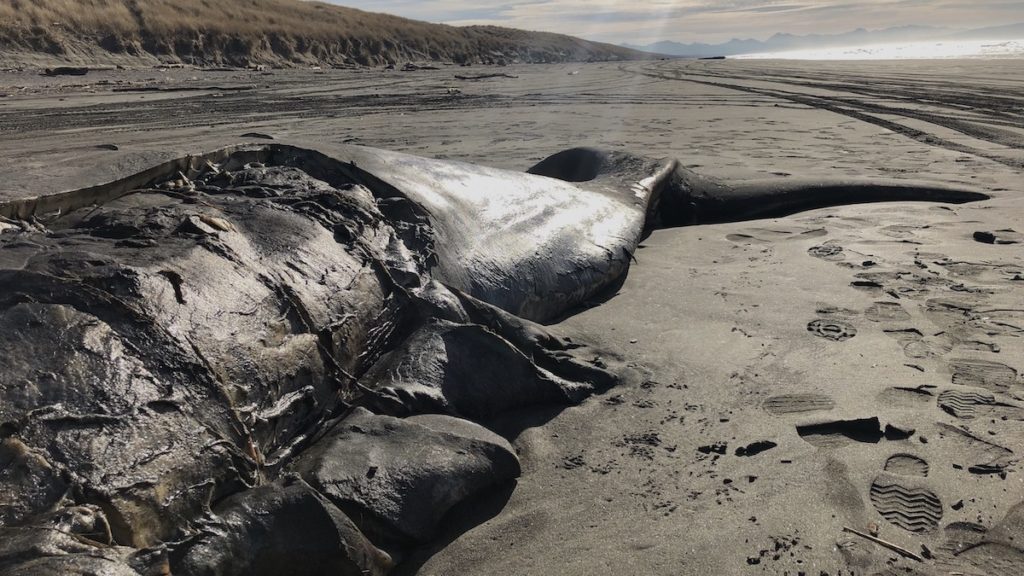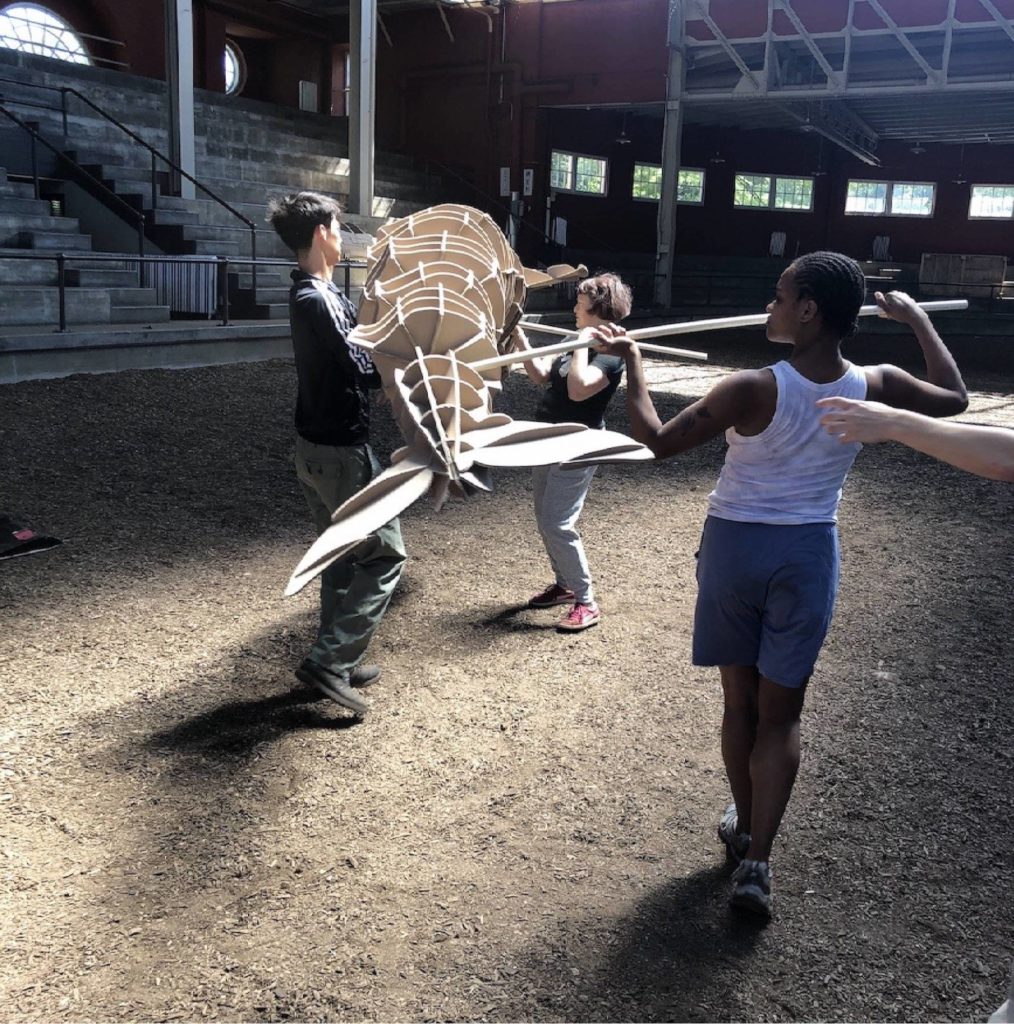This was my first Unreliable Bestiary performance, and although I had seen photos and video clips from previous iterations, and even had the honor of interviewing co-directors Deke Weaver and Jennifer Allen, I still wasn’t entirely sure what to expect. CETACEAN is the sixth in the Unreliable Bestiary series, a life-long project of Weaver’s in which he aims to create a performance representing a threatened animal or habitat for every letter of the alphabet. The previous performances — MONKEY, BEAR, WOLF, ELEPHANT, and TIGER — have all taken place in different locations around Champaign-Urbana. CETACEAN is the first to repeat a location; Weaver returned to the University of Illinois’ Stock Pavilion — also used in 2010’s ELEPHANT — for the latest installment. The Stock Pavilion was originally constructed in 1912 as a place for judging and studying stock, and so it makes perfect sense to use it for this type of performance where animals are on display. As Allen pointed out in my interview with the pair, while for ELEPHANT, the pavilion gave the feeling of a circus tent, for CETACEAN, it reminded them of a boat or the ocean. At one point in the performance, when a sea ranger was educating the audience, the setting also distinctly reminded me of a performance at Sea World or at an aquarium.
CETACEAN is a journey made up of a series of vignettes: narratives by Weaver (often humorous tales, based on folklore and mythology); dance performances, a song, monologues, puppets, sounds, some cars and bull horns, and video and text projected on a massive screen taking up an entire side of the pavilion. Often, multiple things are happening at once. Your experience of the show was also impacted based on where you were sitting and determines what you are taking in at any given moment. It would be impossible for me to recall or capture every single moment, so instead I will highlight some of the most memorable moments.

The performance opened with dancers tying rope in unison. It was a clever and effective way to immediately set the tone; we were at sea, but this was also a performance. Rope tying is precise and methodical but here it was also a rhythmic dance. More figures were moving around them, including Weaver wearing a huge diving helmet. When he eventually took to the mic, he rattled off a list of catastrophes: natural disasters, of course, but there was also mention of things like the opioid crisis and school shootings. Sailors moved behind him, and a whale skeleton was projected on the screen.
Weaver also showed footage of a beached whale (footage I assume he took himself on one of his research trips) while telling a tale of a man who saw the whale and felt it wasn’t quite big enough at 40 feet; the man assumed it would be bigger. After all, Weaver commented, 40 feet can potentially fit in someone’s (very large) living room. At some points, Weaver sat and watched the footage with the audience, not commenting, for instance, when the footage includes a family with young children posing and taking photos with the dead whale as though it were a tourist attraction.

One of my favorite moments in the entire performance happened early on, right after this story about the dissatisfaction of the man with the 40-foot whale. One after another, different types of whales were produced on screen, to scale. At the same time, someone in the center of the pavilion would hold up a sign with the whale type and how long it is, then five more people would shout out the measurement, and more performers would lay out rope indicating the length along the back screen. It happened quickly and frantically so that you heard: “Orca! Twenty four feet!”, for instance, six times in quick succession from performers scattered throughout the pavilion. The whales were listed from smallest to largest with the final one being the blue whale, coming in at a staggering 95 feet. Watching the progression and that demonstration with the string was astounding. It was fun and creative, but also leaves you in awe that such a large creature exists here on earth, and is endangered.
The dancing and movements of the performers was mesmerizing; it occasionally took center stage, but often existed in the background. I enjoyed both, but I especially loved the moments that could have been easily missed. Performers moving slowly, such as when the dancers swayed lightly in a circle, replicating how whales sleep in groups vertically. Or when they moved with boats strapped to their bodies, swaying back and forth as though they were floating at sea. Allen truly did a tremendous job capturing these types of subtle but impactful movements in the choreography that really helped create the feeling of being at sea.
There were a number of the speakers, and they were all engaging. Some provided in-character accounts based off early whale sightings in the nineteenth century. Others filled the roles of sea rangers giving a history or information about the ocean, such as the various levels of the ocean (the bottom level of which we learn is called “the abyss”). There was also a fictional scientist who claimed to speak with Moby Dick, whose “real name was Barry,” and an appearance in song by Captain Ahab from the famous whaling novel.
Sometimes it wasn’t clear whether the vignettes were just there for humor (like when a dolphin attended a disco and got a bunch of women pregnant), while other times the reason for inclusion was less subtle. At one point a group of campers wanted to set up where there was clear evidence of a bear, and someone yelled “We need to change our behavior because otherwise we might die.” [Definitely not a commentary on climate change.]
The end of part one closed with cars driving through the pavilion, honking their horns, accompanied by flashing lights and numerous other sounds, symbolizing the noise pollution that is fundamentally changing and affecting animals daily.
In part two, Weaver recalled a myth of a girl who kept declining proposals before finally agreeing to marry a man. The man is revealed to be a sea bird prince and he carried her away. They live in a nest. He is unkind, and spends all his time off drinking at parties, “and making his big bird decisions.” Her father comes to rescue her. They escape. Sea birds chase them. To save himself, the father pushes the girl overboard. When she tries to climb back up, he cuts off her fingers, then her hands. The father thinks to himself, “I should have done that years ago.” As the myth goes, the tips of her fingers became all the whales in the oceans, her knuckles the seals, and so on and so forth.
Eventually the dolphin, from part one, makes his journey to the bottom of the ocean (after a very humorous encounter with a couple of narwhals). What he finds, in addition to the girl from the myth, is a whole lot of stuff. Here, Weaver reads directly from a list: barbies, dental floss pics, industrial sludge, “Mickey, Donald, and Goofy too”; you can imagine the rest. The mystery that lies at the bottom of the sea, at the bottom of the abyss: all your human garbage.
There was more humor, and more punches to the gut, like when the Mother (Ocean) claimed, “They used to think I was endless, now they can fly across in a few hours” and “You think Earth was born in seven days, it can die in just as many.”

In the foreground of all of this is a large, life-size constructed whale carcass with garbage coming from the cuts that are made in beached whales to prevent them exploding. As the entire above is taking place, performers were moving around it, adding nets constructed of plastic bags.
The performance concludes with a huge piece of fabric controlled by the performers moving gracefully through the pavilion accompanied by a sea song before eventually laying to rest on the whale, acting as a funeral shroud.
Despite having just written many, many words about the performance, I found that the second part in particular left me at a loss for words. Weaver is a talented storyteller. You think you are being set up for the punchline of a joke, only to have the rug pulled out from under you with a devastating comment on the state of the world. The final visual of the beached whale wrapped in plastic nets and covered in fabric was moving, and beautiful, and profound, and the reality that it symbolizes means so much more.








